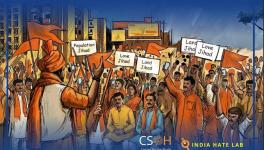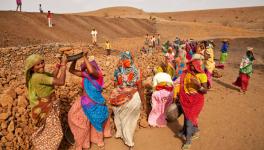Elections 2019: Caste Equation Decides Candidates and Seat-sharing in Bihar
Image for representational use only.Image Courtesy : Inkhabar
The ‘caste equation’ factor is delaying finalisation of the names of the candidates for all the 40 Lok Sabha seats by the Bihar’s ruling NDA as well as by the ‘grand alliance’ or Mahagathbandhan in the state. This delay on both the sides is leading to confusion, uncertainty and speculation in the political circles.
The Lok Sabha election dates have already been declared, and this is a crucial political battle for the BJP-led NDA and the grand alliance of Rashtriya Janata Dal (RJD), Congress, Hindustani Awam Morcha (HAM), Rashtriya Lok Samta Party (RLSP) and Vikasshil Insan Party (VIP). Till date, it is not clear whether Left parties will be a part of this alliance or whether they will go their own way. Others like Mayawati of Bahujan Samaj Party (BSP) have announced that they would contest alone.
In the 2014 Lok Sabha elections, Nitish Kumar’s Janata Dal-United (JD-U) was not part of the NDA. His party contested individually, and performed poorly by winning only two seats, including in Kumar’s home district Nalanda. Then NDA comprised BJP, Lok Janshakti Party (LJP) and RLSP; it had won 31 seats, with share of 22 seats.
RJD, along with Congress and NCP, had won four, two and one seats. Now, Nationalist Congress Party's Tariq Anwar has returned to the Congress. And this time, RLSP of former Union Minister Upendra Kushwaha, HAM of former Chief Minister Jitan Ram Manjhi and VIP of son of Mallah are part of the ‘grand alliance’.
NDA had reportedly finalised the seat sharing formula two and half months ago, but it has not been able to finalise the candidates list. “There are several factors, but caste is more important,” a BJP leader said.
RJD leader Bhai Virendra frankly admitted that everyone relies on castes to win elections, which is also the case with the grand alliance.
NDA leaders are expected to finalise their list before Holi this month, according to a leader.
“Elections cannot be won based on mere drumming of the ‘vikas’ or ‘development’ talk alone. Caste cannot be ignored,” said a JD-U leader.
A political researcher, Satyanarayan Madan, told Newsclick, “Caste is a reality and the arithmetic model to win elections is mainly based on the caste equation. Elections strategies consolidate caste variables or what others may call it ‘social support base’.”
D M Diwakar, a political sociologist, said: “It is not a new phenomenon. Most of the political parties carefully select their candidates and even seats on the basis of castes. If development is everything – as some leaders project – why do their own parties and allies work for ‘social engineering’, which is a euphemism for caste combinations? that is seen as the best hope to win seats.”
In tandem with this belief, BJP and JD-U organised meetings of different caste groups in Patna in November-December last year, and in January-February this year. These parties as well as LJP have more or less decided to field powerful upper caste Bhumihar, Rajput, Brahmin and Kayasth candidates from the parliamentary seats including Munger, Nawada, Begusarai, Motihari, Ara, Aurangabad, Patna Saheb, Darbhanga, Saran, Maharajganj, owing to the sizeable population of these communities.
The caste equation is in favour of OBCs and Extremely Backward Castes (EBCs), in over dozens of seats in Muzaffarpur, Supaul, Jhanjharpur, Bhagalpur, and flood-prone Koshi and Mithilanchal regions in the state. NDA as well as the grand alliance will be necessarily fielding candidates from castes like Yadav or Kurmi, in these areas.
In Nalanda, JD-U has been fielding a candidate from Kurmi caste – the caste of CM Nitish Kumar. Locally, this constituency is known as ‘Kurmistan’, which denotes their domination. Similarly, Madhepura seat is virtually reserved for Yadav candidates by the rival parties.
Ranjeev, an activist pointed out that even though Bhumihar constitute only 3 per cent of Bihar’s population, the caste cannot be ignored, as it is known to have political influence in the state. Bhumihars and Kayasthas have stood behind BJP solidly during several elections in the past.
BJP is confident of the overwhelming support of its traditional support base – upper castes along with non-Yadav OBCs like Kurmi. “BJP and JD-U are also banking heavily upon the EBCs, who constitute nearly 30 per cent of the state’s population, and the scheduled castes (SCs), who constitute 15.7 per cent,” said an NDA leader.
In a bid to make a dent into Yadav vote bank, Ram Kirpal was inducted in Modi cabinet in 2014. Kirpal, then a close associate of Lalu Prasad Yadav, had deserted him, and joined BJP after he was denied ticket to contest parliamentary polls. BJP also appointed Nityaband Rai, a Yadav, as the state party president in 2016.
Earlier, the BJP had also appointed a Yadav, Bhupender Yadav, as party incharge of Bihar.
Yadavs, who constitute nearly 14 percent of Bihar's population, are considered not only loyal to Lalu Prasad, but are also a strong force to counter upper caste dominance in the state politics.
However, JD-U spokesperson Neeraj Kumar said that the party is banking on Nitish Kumar's development and his social engineering of extreme backward castes, Mahadalits and Muslims.
Also read: Bandh Against BJP’s Anti-Dalit, Anti-Adivasi Policy Hits Bihar
Get the latest reports & analysis with people's perspective on Protests, movements & deep analytical videos, discussions of the current affairs in your Telegram app. Subscribe to NewsClick's Telegram channel & get Real-Time updates on stories, as they get published on our website.
























